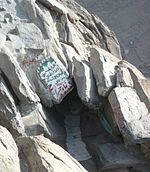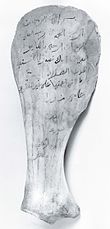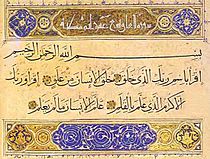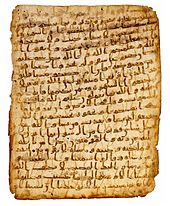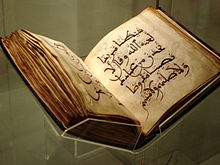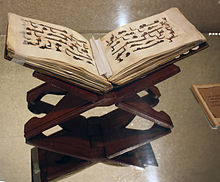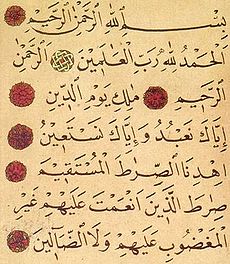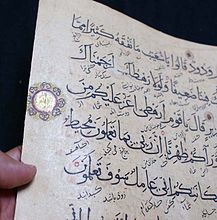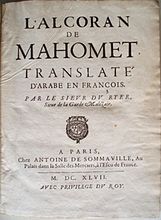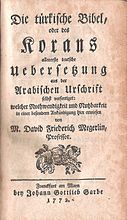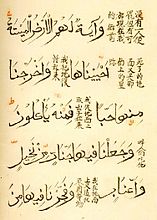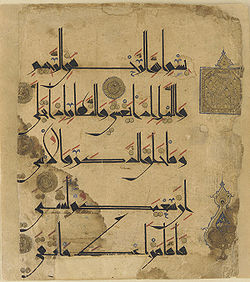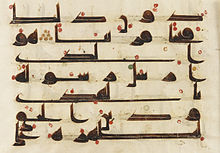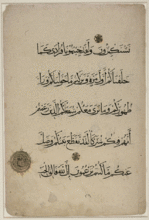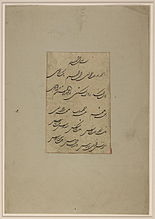
Quran
Background to the schools Wikipedia
SOS Children volunteers helped choose articles and made other curriculum material A good way to help other children is by sponsoring a child
| Quran Al-Qurʾān - (القرآن) |
|||||||||
|---|---|---|---|---|---|---|---|---|---|
 |
|||||||||
|
Quranic division
|
|||||||||
|
Suras
|
|||||||||
|
Prophets in the Quran
|
|||||||||
|
Quran reading
|
|||||||||
|
Translations
List of translations
|
|||||||||
|
History
|
|||||||||
|
Tafsir
|
|||||||||
|
Perspectives
|
|||||||||
|
Related articles
|
|||||||||
|
|||||||||
The Quran (English pronunciation: / k ɔr ˈ ɑː n /[n 1] kor-AHN ; Arabic: القرآن al-qurʾān, IPA: [qurˈʔaːn],[n 2] literally meaning "the recitation", Persian: [ɢoɾˈʔɒːn]), also transliterated Qur'an, Koran, Al-Coran, Coran, Kuran, and Al-Qur'an, is the central religious text of Islam, which Muslims believe to be the verbatim word of God (Arabic: الله, Allah). It is regarded widely as the finest piece of literature in the Arabic language.
Muslims believe the Quran to be verbally revealed through angel Gabriel (Jibril) from God to Muhammad gradually over a period of approximately 23 years beginning on 22 December 609 CE, when Muhammad was 40, and concluding in 632 CE, the year of his death.
Muslims regard the Quran as the main miracle of Muhammad, the proof of his prophethood and the culmination of a series of divine messages that started with the messages revealed to Adam, regarded in Islam as the first prophet, and continued with the Scrolls of Abraham (Suhuf Ibrahim), the Tawrat (Torah or Pentateuch) of Moses, the Zabur (Tehillim or Book of Psalms) of David, and the Injil ( Gospel) of Jesus. The Quran assumes familiarity with major narratives recounted in Jewish and Christian scriptures, summarizing some, dwelling at length on others and in some cases presenting alternative accounts and interpretations of events. The Quran describes itself as a book of guidance, sometimes offering detailed accounts of specific historical events, and often emphasizing the moral significance of an event over its narrative sequence. The Quran is used along with the hadith to interpret sharia law.
Etymology and meaning
The word qurʾān appears about 70 times in the Quran itself, assuming various meanings. It is a verbal noun ( maṣdar) of the Arabic verb qaraʾa (قرأ), meaning “he read” or “he recited.” The Syriac equivalent is qeryānā, which refers to “scripture reading” or “lesson”. While most Western scholars consider the word to be derived from the Syriac, the majority of Muslim authorities hold the origin of the word is qaraʾa itself. In any case, it had become an Arabic term by Muhammad's lifetime. An important meaning of the word is the “act of reciting”, as reflected in an early Quranic passage: “It is for Us to collect it and to recite it (qurʾānahu)”.
In other verses, the word refers to “an individual passage recited [by Muhammad]”. Its liturgical context is seen in a number of passages, for example: "So when al-qurʾān is recited, listen to it and keep silent". The word may also assume the meaning of a codified scripture when mentioned with other scriptures such as the Torah and Gospel.
The term also has closely related synonyms that are employed throughout the Quran. Each synonym possesses its own distinct meaning, but its use may converge with that of qurʾān in certain contexts. Such terms include kitāb (“book”); āyah (“sign”); and sūrah (“scripture”). The latter two terms also denote units of revelation. In the large majority of contexts, usually with a definite article (al-), the word is referred to as the “revelation” ( wahy), that which has been “sent down” ( tanzīl) at intervals. Other related words are: dhikr, meaning "remembrance," used to refer to the Quran in the sense of a reminder and warning; and ḥikma, meaning “wisdom”, sometimes referring to the revelation or part of it.
The Quran describes itself as "the discernment or the criterion between truth and falsehood" (al-furqan), "the mother book" (umm al-kitab), "the guide" (huda), "the wisdom" (hikmah), "the remembrance" (dikr), and "the revelation" (tanzil; something sent down, signifying the descent of an object from a higher place to lower place). Another term is al-kitab (“the book”), though it is also used in the Arabic language for other scriptures, such as the Torah and the Gospels. The term mus'haf ("written work") is often used to refer to particular Quranic manuscripts but is also used in the Quran to identify earlier revealed books.
History
Prophetic era
Islamic tradition relates that Muhammad received his first revelation in the Cave of Hira during one of his isolated retreats to the mountains. Thereafter, he received revelations over a period of twenty-three years. According to hadith and Muslim history, after Muhammad emigrated to Medina and formed an independent Muslim community, he ordered a considerable number of the sahabah to recite the Quran and to learn and teach the laws, which were revealed daily. Companions who engaged in the recitation of the Quran were called Qari. Since most sahabah were unable to read or write, they were ordered to learn from the prisoners-of-war the simple writing of the time. Thus a group of sahabah gradually became literate. As it was initially spoken, the Quran was recorded on tablets, bones and the wide, flat ends of date palm fronds. Most chapters were in use amongst early Muslims since they are mentioned in numerous sayings by both Sunni and Shia sources, relating Muhammad's use of the Quran as a call to Islam, the making of prayer and the manner of recitation. However, the Quran did not exist in book form at the time of Muhammad's death in 632.
Sahih Bukhari narrates Muhammad describing the revelations as, "Sometimes it is (revealed) like the ringing of a bell" and Aisha reported, "I saw the Prophet being inspired Divinely on a very cold day and noticed the sweat dropping from his forehead (as the Inspiration was over)". The Islamic studies scholar Welch states in the Encyclopaedia of Islam that he believes the graphic descriptions of Muhammad's condition at these moments may be regarded as genuine, because he was severely disturbed after these revelations. According to Welch, these seizures would have been seen by those around him as convincing evidence for the superhuman origin of Muhammad's inspirations. However, Muhammad's critics accused him of being a possessed man, a soothsayer or a magician since his experiences were similar to those claimed by such figures well known in ancient Arabia. Welch additionally states that it remains uncertain whether these experiences occurred before or after Muhammad's initial claim of prophethood.
The Quran states that Muhammad was ummi, interpreted as illiterate in Muslim tradition. According to Watt, the meaning of the Quranic term ummi is unscriptured rather than illiterate.
Compilation
Based on earlier transmitted reports, shortly after Muhammad's death in the year 632 CE, the first caliph Abu Bakr decided to collect the book in one volume. Thus, a group of scribes, most importantly Zayd ibn Thabit, collected the verses and produced several hand-written copies of the complete book. Zayd's reaction to the task and the difficulties in collecting the Quranic material from parchments, palm-leaf stalks, thin stones and from men who knew it by heart is recorded in earlier narratives. Hafsa bint Umar, Muhammad's widow and Caliph Umar's daughter, was entrusted with that Quranic text. In about 650 CE, when the third Caliph Uthman ibn Affan began noticing slight differences in pronunciation of the Quran, and as Islam expanded beyond the Arabian peninsula into Persia, the Levant and North Africa, in order to preserve the sanctity of the text, ordered a committee to use Hafsa's text and prepare a standard copy of the text of Quran. Thus, within twenty years of Muhammad’s death, the Quran was committed to written form. That text became the model from which copies were made and promulgated throughout the urban centers of the Muslim world, and other versions are believed to have been destroyed. The present form of the Quran text is accepted by Muslim scholars to be the original version compiled by Abu Bakr.
According to Shias and some Sunni scholars, Ali ibn Abi Talib compiled a complete version of the Quran immediately after Muhammad's death. The order of this text differed from that gathered later during Uthman's era in that this version had been collected in chronological order. Despite this, he made no objection against the standardized Quran, but kept his own book. Other personal copies of the Quran might have existed including ibn Masud's and Ubayy ibn Kab's codex, none of which exist today.
Qur'an most likely existed in scattered written form during the life of the Prophet, Muslim scholars believe that it was written as a complete text at the time of the Prophet’s death. The Quran in its present form is generally considered by academic scholars to record the words spoken by Muhammad because the search for variants has not yielded any differences of great significance. Although most variant readings of the text of the Quran have ceased to be transmitted, some still are. There has been no critical text produced on which a scholarly reconstruction of the Quranic text could be based. Historically, controversy over the Quran's content has rarely become an issue, although debates continue on the subject.
In 1972 in a mosque in the city of Sana'a, Yemen, manuscripts were discovered that were later proved to be the most ancient Quranic text. The sana'a manuscripts contain palimpsets, a manuscript page from which the text has been washed off to make the parchment reusable again, a practice which was common in ancient times due to scarcity of writing material. The faint washed off underlying text, scriptio inferior, however is still barely visible and believed to be "pre-Uthmanic" Quranic content, whilst the text written on top, scriptio superior, is believed to belong to Uthmanic time. Recent studies using radiocarbon dating indicates that the parchments have high probability of belonging to the period between 614 CE to 656 CE.
Significance in Islam
Muslims believe the Quran to be the book of divine guidance and direction for humanity and consider the text in its original Arabic to be the literal word of God, revealed to Muhammad through the angel Gabriel over a period of twenty-three years and view the Quran as God's final revelation to humanity.They also believe that the Quran has solutions to all the problems of humanity irrespective of how complex they may be and in what age they occur.
Wahy in Islamic and Quranic concept means the act of God addressing an individual, conveying a message for a greater number of recipients. The process by which the divine message comes to the heart of a messenger of God is tanzil (to send down) or nuzul (to come down). As the Quran says, "With the truth we (God) have sent it down and with the truth it has come down." It designates positive religion, the letter of the revelation dictated by the angel to the prophet. It means to cause this revelation to descend from the higher world. According to hadith, the verses were sent down in special circumstances known as asbab al-nuzul. However, in this view God himself is never the subject of coming down.
The Quran frequently asserts in its text that it is divinely ordained, an assertion that Muslims believe. The Quran – often referring to its own textual nature and reflecting constantly on its assertion of divine origin – is the most meta-textual, self-referential religious text. Some verses in the Quran seem to imply that even those who do not speak Arabic would understand the Quran if it were recited to them. The Quran refers to a written pre-text that records God's speech even before it was sent down.
The issue of whether the Quran is eternal or created was one of the crucial controversies among early Muslim theologians. Mu'tazilis believe it is created while the most widespread varieties of Muslim theologians consider the Quran to be eternal and uncreated. Sufi philosophers view the question as artificial or wrongly framed.
Muslims maintain the present wording of the Quranic text corresponds exactly to that revealed to Muhammad himself: as the words of God, said to be delivered to Muhammad through the angel Gabriel. Muslims consider the Quran to be a guide, a sign of the prophethood of Muhammad and the truth of the religion. They argue it is not possible for a human to produce a book like the Quran, as the Quran itself maintains.
Therefore an Islamic philosopher introduces a prophetology to explain how the divine word passes into human expression. This leads to a kind of esoteric hermeneutics that seeks to comprehend the position of the prophet by mediating on the modality of his relationship not with his own time, but with the eternal source his message emanates from. This view contrasts with historical critique of western scholars who attempt to understand the prophet through his circumstances, education and type of genius.
The Basic Law of Saudi Arabia declares the Quran and sunnah the sole constitutional law of the kingdom.
Uniqueness
Muslims believe that the Quran is different from all other books in ways that are impossible for any other book to be, such that similar texts cannot be written by humans. These include both mundane and miraculous claims. The Quran itself challenges any who disagree with its divine origin to produce a text of a miraculous nature.
Scholars of Islam believe that its poetic form is unique and of a fashion that cannot be written by humans. They also claim it contains accurate prophecy and that no other book does.
Text
The Quran consists of 114 chapters of varying lengths, each known as a sura. Chapters are classified as Meccan or Medinan, depending on whether the verses were revealed before or after the migration of Muhammad to the city of Medina. Chapter titles are derived from a name or quality discussed in the text, or from the first letters or words of the sura. Generally, longer chapters appear earlier in the Quran, while the shorter ones appear later. The chapter arrangement is thus not connected to the sequence of revelation. Each chapter except the ninth starts with the Bismillah (بسم الله الرحمن الرحيم) an Arabic phrase meaning “In the name of God”. There are, however, still 114 occurrences of the bismillah in the Quran, due to its presence in verse 27:30 as the opening of Solomon's letter to the Queen of Sheba.
Each chapter is formed from several verses, known as ayat, which originally means a “sign” or “evidence” sent by God. The number of verses differs from chapter to chapter. An individual verse may be just a few letters or several lines. The total number of verses in the Quran is 6,236, however, the number varies if the bismillahs are counted separately.
In addition to and independent of the division into chapters, there are various ways of dividing the Quran into parts of approximately equal length for convenience in reading. The thirty juz' (plural ajza) can be used to read through the entire Quran in a month. Some of these parts are known by names and these names are the first few words by which the juz' starts. A juz' is sometimes further divided into two hizb (plural ahzab), and each hizb subdivided into four rub 'al-ahzab. The Quran is also divided into seven approximately equal parts, manzil (plural manazil), for it to be recited in a week.
Muqatta'at or the Quranic initials are fourteen different letter combinations of 14 Arabic letters that appear in the beginning of 29 chapters of the Quran. The meanings of these initials remain unclear.
According to one estimate the Quran consists of 77430 words, 18994 unique words, 12183 stems, 3382 lemmas and 1685 roots.
Contents
The Quranic content is concerned with the basic beliefs of Islam which include the existence of God and the resurrection. Narratives of the early prophets, ethical and legal subjects, historical events of the prophet’s time, charity and prayer also appear in the Quran. The Quranic verses contain general exhortations regarding right and wrong and the nature of revelation. Historical events are related to outline general moral lessons. Verses pertaining to natural phenomena have been interpreted by Muslims as an indication of the authenticity of the Quranic message.
The central theme of the Quran is monotheism. God is depicted as living, eternal, omniscient and omnipotent (2:20,29,255). God's omnipotence appears above all in his power to create. He is the creator of everything, of the heavens and the earth and what is between them (13:16, 50:38, etc.) All human beings are equal in their utter dependence upon God, and their well-being depends upon their acknowledging that fact and living accordingly.
The Quran uses cosmological and contigency arguments in various verses without referring to the terms to prove the existence of God. Therefore, the universe is originated and needs an originator, and whatever exists must have a sufficient cause for its existence. Besides, the design of the universe, is frequently referred to as a point of contemplation: "It is He who has created seven heavens in harmony. You cannot see any fault in God's creation; then look again: Can you see any flaw?’ (67:3)
The doctrine of the last day and eschatology (the final fate of the universe) may be reckoned as the second great doctrine of the Quran. It is estimated that around a full one-third of the Quran is eschatological, dealing with the afterlife in the next world and with the day of judgment at the end of time. There is a reference of the afterlife on most pages of the Quran and the belief in the afterlife is often referred to in conjunction with belief in God as in the common expression: "if you believe in God and the last day". A number of chapters such as 44,56,75,78,81,101 are directly related to the afterlife and its preparations. Some of the chapters indicate the closeness of the event and warn people to be prepared for the imminent day. For instance, the first verses of chapter 22, which deal with the mighty earthquake and the situations of people on that day, represent this style of divine address: O People! Be respectful to your Lord. The earthquake of the Hour is a mighty thing."
The Quran is often vivid in its depiction of what will happen at the end time. According to Watt's description of the end time in the Quran: "The climax of history, when the present world comes to an end, is referred to in various ways. It is 'the Day of Judgment', 'the Last Day', 'the Day of Resurrection', or simply 'the Hour'. Less frequently it is 'the Day of Distinction' (when the good are separated from the evil), 'the Day of the Gathering' (of men to the presence of God) or 'the Day of the Meeting' (of men with God). The Hour comes suddenly. It is heralded by a shout, by a thunderclap, or by the blast of a trumpet. A cosmic upheaval then takes place. The mountains dissolve into dust, the seas boil up, the sun is darkened, the stars fall, and the sky is rolled up... The central interest, of course, is in the gathering of all mankind before the Judge. Human beings of all ages, restored to life, join the throng... and to the objection of the Meccan pagans that former generations had been dead a long time and were now dust and mouldering bones, the reply is that God is nevertheless able to restore them to life, though they will have no knowledge of the time that has elapsed."
Literary structure
The Quran's message is conveyed with various literary structures and devices. In the original Arabic, the chapters and verses employ phonetic and thematic structures that assist the audience's efforts to recall the message of the text. Muslims assert (according to the Quran itself) that the Quranic content and style is inimitable.
The language of the Quran has been described as "rhymed prose" as it partakes of both poetry and prose, however, this description runs the risk of compromising the rhythmic quality of Quranic language, which is certainly more poetic in some parts and more prose-like in others. Rhyme while found throughout the Quran is conspicuous in many of the earlier Meccan chapters, in which relatively short verses throw the rhyming words into prominence. The effectiveness of such a form is evident for instance in chapter 81, and there can be no doubt that these passages impressed the conscience of the hearers. Frequently a change of rhyme from one set of verses to another signals a change in the subject of discussion. Later sections also preserve this form but the style is more expository.
The Quranic text seems to have no beginning, middle, or end, its nonlinear structure being akin to a web or net. The textual arrangement is sometimes considered to have lack of continuity, absence of any chronological or thematic order and presence of repetition. Michael Sells, citing the work of the critic Norman O. Brown, acknowledges Brown's observation that the seeming disorganization of Quranic literary expression – its scattered or fragmented mode of composition in Sells's phrase – is in fact a literary device capable of delivering profound effects as if the intensity of the prophetic message were shattering the vehicle of human language in which it was being communicated. Sells also addresses the much-discussed repetitiveness of the Quran, seeing this, too, as a literary device.
Interpretation
Tafsir
The Quran has sparked a huge body of commentary and explication (tafsir), aimed at explaining the "meanings of the Quranic verses, clarifying their import and finding out their significance."
Tafsir is one of the earliest academic activities of Muslims. According to the Quran, Muhammad was the first person who described the meanings of verses for early Muslims. Other early exegetes included a few Companions of Muhammad, like Ali ibn Abi Talib, Abdullah ibn Abbas, Abdullah ibn Umar and Ubayy ibn Kab. Exegesis in those days was confined to the explanation of literary aspects of the verse, the background of its revelation and, occasionally, interpretation of one verse with the help of the other. If the verse was about a historical event, then sometimes a few traditions ( hadith) of Muhammad were narrated to make its meaning clear.
Because the Quran is spoken in classical Arabic, many of the later converts to Islam (mostly non-Arabs) did not always understand the Quranic Arabic, they did not catch allusions that were clear to early Muslims fluent in Arabic and they were concerned with reconciling apparent conflict of themes in the Quran. Commentators erudite in Arabic explained the allusions, and perhaps most importantly, explained which Quranic verses had been revealed early in Muhammad's prophetic career, as being appropriate to the very earliest Muslim community, and which had been revealed later, canceling out or " abrogating" (nasikh) the earlier text (mansukh). Other scholars, however, maintain that no abrogation has taken place in the Qur'an.
Ta'wil
Ja'far Kashfi defines ta'wil as 'to lead back or to bring something back to its origin or archetype'. It is a science whose pivot is a spiritual direction and a divine inspiration, while the tafsir is the literal exegesis of the letter; its pivot is the canonical Islamic sciences. Muhammad Husayn Tabatabaei says that according to the popular explanation among the later exegetes, ta'wil indicates the particular meaning a verse is directed towards. The meaning of revelation ( tanzil), as opposed to ta'wil, is clear in its accordance to the obvious meaning of the words as they were revealed. But this explanation has become so widespread that, at present, it has become the primary meaning of ta'wil, which originally meant "to return" or "the returning place". In Tabatabaei's view, what has been rightly called ta'wil, or hermeneutic interpretation of the Quran, is not concerned simply with the denotation of words. Rather, it is concerned with certain truths and realities that transcend the comprehension of the common run of men; yet it is from these truths and realities that the principles of doctrine and the practical injunctions of the Quran issue forth. Interpretation is not the meaning of the verse; rather it transpires through that meaning – a special sort of transpiration. There is a spiritual reality, which is the main objective of ordaining a law, or the basic aim in describing a divine attribute—and there is an actual significance a Quranic story refers to.
According to Shia beliefs, those who are firmly rooted in knowledge like the Prophet and the imams know the secrets of the Quran. According to Tabatabaei, the statement "none knows its interpretation except Allah"(3:7 ) remains valid, without any opposing or qualifying clause. Therefore, so far as this verse is concerned, the knowledge of the Quran's interpretation is reserved for God. But Tabatabaei uses other verses and concludes that those who are purified by God know the interpretation of the Quran to a certain extent. As Corbin narrates from Shia sources, Ali himself gives this testimony:
"Not a single verse of the Quran descended upon (was revealed to) the Messenger of God, which he did not proceed to dictate to me and make me recite. I would write it with my own hand, and he would instruct me as to its tafsir (the literal explanation) and the ta'wil (the spiritual exegesis), the nasikh (the verse that abrogates) and the mansukh (the abrogated verse), the muhkam (without ambiguity) and the mutashabih (ambiguous), the particular and the general..."
According to Tabatabaei, there are acceptable and unacceptable esoteric interpretations. Acceptable ta'wil refers to the meaning of a verse beyond its literal meaning; rather the implicit meaning, which ultimately is known only to God and can't be comprehended directly through human thought alone. The verses in question here refer to the human qualities of coming, going, sitting, satisfaction, anger, and sorrow, which are apparently attributed to God. Unacceptable ta'wil is where one "transfers" the apparent meaning of a verse to a different meaning by means of a proof; this method is not without obvious inconsistencies. Although this unacceptable ta'wil has gained considerable acceptance, it is incorrect and cannot be applied to the Quranic verses. The correct interpretation is that reality a verse refers to. It is found in all verses, the decisive and the ambiguous alike; it is not a sort of a meaning of the word; it is a fact that is too sublime for words. God has dressed them with words to bring them a bit nearer to our minds; in this respect they are like proverbs that are used to create a picture in the mind, and thus help the hearer to clearly grasp the intended idea.
Therefore Sufi spiritual interpretations are usually accepted by Islamic scholars as authentic, as long as certain conditions are met. In Sufi history, these interpretations were sometimes considered religious innovations ( bid'ah), as Salafis believe today. However, ta'wil is extremely controversial even amongst Shia. For example, when Ayatollah Ruhallah Khomeini, the leader of Islamic revolution, gave some lectures about Sura al-Fatiha in December 1979 and January 1980, protests forced him to suspend them before he could continue beyond the first two verses of the surah.
Levels of meaning
Unlike the Salafis and Zahiri, Shias and Sufis as well as some other Muslim philosophers believe the meaning of the Quran is not restricted to the literal aspect. For them, it is an essential idea that the Quran also has inward aspects. Henry Corbin narrates a hadith that goes back to Muhammad:
"The Qur'an possesses an external appearance and a hidden depth, an exoteric meaning and an esoteric meaning. This esoteric meaning in turn conceals an esoteric meaning (this depth possesses a depth, after the image of the celestial Spheres, which are enclosed within each other). So it goes on for seven esoteric meanings (seven depths of hidden depth)."
According to this view, it has also become evident that the inner meaning of the Quran does not eradicate or invalidate its outward meaning. Rather, it is like the soul, which gives life to the body. Corbin considers the Quran to play a part in Islamic philosophy, because gnosiology itself goes hand in hand with prophetology.
Commentaries dealing with the zahir (outward aspects) of the text are called tafsir, and hermeneutic and esoteric commentaries dealing with the batin are called ta'wil (“interpretation” or “explanation”), which involves taking the text back to its beginning. Commentators with an esoteric slant believe that the ultimate meaning of the Quran is known only to God. In contrast, Quranic literalism, followed by Salafis and Zahiris, is the belief that the Quran should only be taken at its apparent meaning.
Translations
Translation of the Quran has always been a problematic and difficult issue. Many argue that the Quranic text cannot be reproduced in another language or form. Furthermore, an Arabic word may have a range of meanings depending on the context, making an accurate translation even more difficult.
Nevertheless, the Quran has been translated into most African, Asian and European languages. The first translator of the Quran was Salman the Persian, who translated sura Al-Fatiha into Persian during the 7th century. The first complete translation of the Quran was completed in 884 CE in Alwar ( Sindh, India now Pakistan) by the orders of Abdullah bin Umar bin Abdul Aziz on the request of the Hindu Raja Mehruk. The first complete translation of Quran was into Persian during the reign of Samanids in the 9th century. Islamic tradition holds that translations were made for Emperor Negus of Abyssinia and Byzantine Emperor Heraclius, as both received letters by Muhammad containing verses from the Quran. In early centuries, the permissibility of translations was not an issue, but whether one could use translations in prayer.
In 1936, translations in 102 languages were known. In 2010, the Hürriyet Daily News and Economic Review reported that the Quran was presented in 112 languages at the 18th International Quran Exhibition in Tehran.
Robert of Ketton's 1143 translation of the Quran for Peter the Venerable, Lex Mahumet pseudoprophete, was the first into a Western language (Latin). Alexander Ross offered the first English version in 1649, from the French translation of L'Alcoran de Mahomet (1647) by Andre du Ryer. In 1734, George Sale produced the first scholarly translation of the Quran into English; another was produced by Richard Bell in 1937, and yet another by Arthur John Arberry in 1955. All these translators were non-Muslims. There have been numerous translations by Muslims.
The English translators have sometimes favored archaic English words and constructions over their more modern or conventional equivalents; for example, two widely read translators, A. Yusuf Ali and M. Marmaduke Pickthall, use the plural and singular "ye" and "thou" instead of the more common " you".
Recitation
Rules of recitation
The proper recitation of the Quran is the subject of a separate discipline named Tajwid which determines in detail how the Quran should be recited, how each individual syllable is to be pronounced, the need to pay attention to the places where there should be a pause, to elisions, where the pronunciation should be long or short, where letters should be sounded together and where they should be kept separate, and so on. It may be said that this discipline studies the laws and methods of the proper recitation of the Quran and covers three main areas: the proper pronunciation of consonants and vowels (the articulation of the Quranic phonemes), the rules of pause in recitation and of resumption of recitation, and the musical and melodious features of recitation.
In order to avoid incorrect articulation reciters who are not native speakers of arabic language try to follow a training in countries such as Egypt or Saudi Arabia. The recitations of a few of Egyptian reciters were highly influential in the art of recitation. The region of Southeast Asia is well known for world-class recitation, evidenced in the popularity of the woman reciters such as Maria Ulfah from Jakarta.
There are two types of recitation: 'Murattal' is at a slower pace, used for study and practice. 'Mujawwad' refers to a slow recitation that deploys heightened technical artistry and melodic modulation, as in public performances by trained experts. It is directed to and depenent upon an audience for the 'Mujawwad' reciter seeks to involve the listeners.
Variant readings
Vocalization markers indicating specific vowel sounds were introduced into arabic language by the end of the ninth century. The first Qur'anic manuscripts lacked these marks, therefore several recitations remains acceptable. The variation in readings of the text permitted by the nature of the defective vocalization led to an increase in the number of readings during the tenth century. The tenth century muslim scholar from Baghdad, Ibn Mujahid, is famous for establishing seven acceptable textual readings of the Qur'an. He studied various readings and their trustworthiness and chose seven eight century readers from the cities of Mecca, Medina, Kufa, Basra and Damascus. Ibn Mujahid did not explain why he chose seven readers rather than six or ten but this may be related to a prophetic tradition (Muhammad's saying) reporting that the Qur'an had been revealed in seven "ahruf" (meaning seven letters or modes). Today, the most popular readings are those transmitted by Hafs (d.796) and Warsh (d. 812) which are according to two of Ibn Mujahid's reciters Asim (Kufa, d.745) and Nafi (Medina, d.785) respectively. The influential standard Qur'an of Cairo (1924) uses an elaborate system of modified vowel-signs and a set of additional symbols for minute details and is based on Asim's recitation.
The variant readings of the Qur'an do not relate to any textual variation, instead, all of the readings pertain to differences in the vocalization of the same text. According to Melchert the majority of disagreements have to do with vowels to supply, most of them in turn not conceivably reflecting dialectal differences and about one in eight disagreements has to do with whether to place dots above or below the line.
Nasser categorizes various readings into various subtypes. Some of Nasser's categories are internal vowels, long vowels, gemination (shadda), assimilation and alternation.
Occasionally, early Qur'ans show more compatibility with a particular reading. A Syrian manuscript from the eighth century is shown to have been written according to the reading of Ibn Amir of Damascus. Another study suggests that this manuscript bears the vocalization of himsi region.
Writing and printing
Writing
Before printing was widely adopted in the 19th century, the Quran was transmitted in manuscripts made by calligraphers and copyists. The earliest manuscripts were written in hijazi type script. The hijazi style manuscripts nevertheless confirm that transmission of the Quran in writing began at an early stage. Probably in the ninth century scripts began to feature thicker strokes, which are traditionally known as Kufic scripts. Toward the end of the ninth century, new scripts began to appear in copies of the Quran and replace earlier scripts. The reason for discontinuation in the use of the earlier style was that it took too long to produce and the demand for copies was increasing. Copyists would therefore chose simpler writing styles. From the eleventh century, the styles of writing employed were primarily the Naskhi, muhaqqaq, rayhani and on rarer occasions the thuluth script. Naskhi was in very widespread use. In North Africa and Spain the maghribi style was popular. More distinct is the bihari script which was used solely in the north of India. Nastaliq style was also rarely used in Persian world.
In the beginning the Quran did not have vocalization markings. The system of vocalization as we know it today seems to have been introduced towards the end of the ninth century. Since it would have been too costly for most Muslims to purchase a manuscript, copies of the Quran were held in mosques in order to make them accessible to people. These copies frequently took the form of a series of thirty parts or Juz'. In terms of productivity the Ottoman copyists would provide the best example. This was in response to widespread demand, unpopularity of printing methods, and for aesthetic reasons.
Printing
Short extracts from the Quran were printed as early as the tenth century in various parts of the Muslim world with a method known as wood-block printing. In this technique a page is carved in a wooden block, one block per page. A similar technique was widely used in China. Another technique, known as movable-type printing, was used to print the Quran in Venice around 1537. Two more editions include those published by the pastor Abraham Hinckelmann in Hamburg in 1694 and by Italian priest Ludovico Maracci in Padua in 1698. The latter print included an accurate Latin translation. In 1787 in Saint Petersburg, Catherine the Great of Russia, sponsored a print of the Quran by a Muslim scholar named Mullah Osman Ismail. This was followed by editions from Kazan (1803), Tehran (1828) and Istanbul (1877). Gustav Flügel published an edition of the Quran in 1834 in Leipzig, which became popular in Europe. This edition provided a large number of readers with access to a reliable text and was referred to for a long time thereafter, until the publication of an edition of the Quran in Cairo in 1924 which was the result of a long preparation process by scholars from al-Azhar university. This edition which standardized the orthography of the Quran is the basis of current editions of the Quran.
Relationship with other literature
The Bible
| “ | It is He Who sent down to thee (step by step), in truth, the Book, confirming what went before it; and He sent down the Law (of Moses) and the Gospel (of Jesus) before this, as a guide to mankind, and He sent down the criterion (of judgment between right and wrong). | ” |
|
—Quran 3:3 ( Yusuf Ali) |
||
The Quran speaks well of the relationship it has with former books (the Torah and the Gospel) and attributes their similarities to their unique origin and saying all of them have been revealed by the one God.
According to Sahih Bukhari, the Quran was recited among Levantines and Iraqis, and discussed by Christians and Jews before it was standardized. Its language was similar to the Syriac language. The Quran recounts stories of many of the people and events recounted in Jewish and Christian sacred books ( Tanakh, Bible) and devotional literature (Apocrypha, Midrash), although it differs in many details. Adam, Enoch, Noah, Eber, Shelah, Abraham, Lot, Ishmael, Isaac, Jacob, Joseph, Job, Jethro, David, Solomon, Elijah, Elisha, Jonah, Aaron, Moses, Zechariah, John the Baptist, and Jesus are mentioned in the Quran as prophets of God (see Prophets of Islam). In fact, Moses is mentioned more in the Quran than any other individual. Jesus is mentioned more often in the Quran than Muhammad while Mary is mentioned in the Quran more than the New Testament. Muslims believe the common elements or resemblances between the Bible and other Jewish and Christian writings and Islamic dispensations is due to their common divine source, and that the original Christian or Jewish texts were authentic divine revelations given to prophets.
Similarities with Christian apocrypha
The Quran has been noted to have certain narratives similarities to the Diatessaron, Protoevangelium of James, Infancy Gospel of Thomas, Gospel of Pseudo-Matthew and the Arabic Infancy Gospel. One scholar has suggested that the Diatessaron, as a gospel harmony, may have led to the conception that the Christian Gospel is one text.
Arab writing
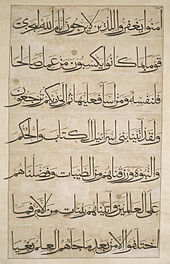
After the Quran, and the general rise of Islam, the Arabic alphabet developed rapidly into an art form.
Wadad Kadi, Professor of Near Eastern Languages and Civilizations at University of Chicago and Mustansir Mir, Professor of Islamic studies at Youngstown State University state that:
Although Arabic, as a language and a literary tradition, was quite well developed by the time of Muhammad's prophetic activity, it was only after the emergence of Islam, with its founding scripture in Arabic, that the language reached its utmost capacity of expression, and the literature its highest point of complexity and sophistication. Indeed, it probably is no exaggeration to say that the Quran was one of the most conspicuous forces in the making of classical and post-classical Arabic literature.
The main areas in which the Qur'an exerted noticeable influence on Arabic literature are diction and themes; other areas are related to the literary aspects of the Qur'an particularly oaths (q.v.), metaphors, motifs, and symbols. As far as diction is concerned, one could say that Qur'anic words, idioms, and expressions, especially "loaded" and formulaic phrases, appear in practically all genres of literature and in such abundance that it is simply impossible to compile a full record of them. For not only did the Qur'an create an entirely new linguistic corpus to express its message, it also endowed old, pre-Islamic words with new meanings and it is these meanings that took root in the language and subsequently in the literature...
Culture
Respect for the written text of the Quran is an important element of religious faith by many Muslims. They believe that intentionally insulting the Quran is a form of blasphemy.
Many Muslims memorize at least some portion of the Quran in the original Arabic, usually at least the verses needed to perform the contact prayers ( solat). Those who have memorized the entire Quran earn the right to the title of Hafiz.
The text of the Quran has become readily accessible over the internet, in Arabic as well as numerous translations in other languages. It can be downloaded and searched both word-by-word and with Boolean algebra. Photos of ancient manuscripts and illustrations of Quranic art can be witnessed. However, there are still limits to searching the Arabic text of the Quran.
Treatment and disposal of the book
Most Muslims treat paper copies of the Quran with reverence. Based on tradition and a literal interpretation of sura 56:77–79: "That this is indeed a Quran Most Honourable, In a Book well-guarded, Which none shall touch but those who are clean", many scholars believe that a Muslim must perform a ritual cleansing with water ( wudu) before touching a copy of the Quran, or mus'haf, although this view is not universal.
Defiling or dismembering copies of the Quran is considered Quran desecration. Pulping, recycling, or otherwise discarding worn-out copies of the text is forbidden. Worn-out, torn, or errant (for example, pages out of order) Qurans are left free to flow in a river, kept somewhere safe, burned, or buried in a remote location.
